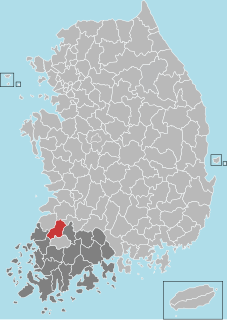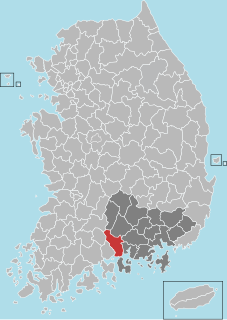
Korean Buddhism is distinguished from other forms of Buddhism by its attempt to resolve what it sees as inconsistencies in Mahayana Buddhism. Early Korean monks believed that the traditions they received from foreign countries were internally inconsistent. To address this, they developed a new holistic approach to Buddhism. This approach is characteristic of virtually all major Korean thinkers, and has resulted in a distinct variation of Buddhism, which is called Tongbulgyo, a form that sought to harmonize all disputes by Korean scholars. Korean Buddhist thinkers refined their predecessors' ideas into a distinct form.

North Jeolla Province, also known as Jeonbuk, is a province of South Korea. North Jeolla has a population of 1,869,711 (2015) and has a geographic area of 8,067 km2 located in the Honam region in the southwest of the Korean Peninsula. North Jeolla borders the provinces of South Jeolla to the south, North Gyeongsang and South Gyeongsang to the east, North Chungcheong to the northeast, and South Chungcheong to the north.

Gangjin County (Gangjin-gun) is a county in South Jeolla Province, South Korea. Gangjin county proper was established in 1895. The county office is located in Gangjin-eup.

Zangseong County (Jangseong-gun) is a county in South Jeolla Province, South Korea.

Gimje (Gimje-si) is a city in North Jeolla Province, South Korea.

Buan County (Buan-gun) is a county in North Jeolla Province, South Korea. It is bounded by the city of Jeongeup on the east, the county of Gochang on the south, the city of Gimje on the north, and Yellow Sea on the west. Buan is divided into 1 eup, 12 myeon, and 510 ri. Buan had a 2001 estimated population of 74,716 people and a 2018 population of 54,441 people with an area of 493.35 km2. Famous people from Buan include Joseon Dynasty kisaeng and poet, Yi Mae-chang. Like many rural areas in southern Korea, it has seen shrinking population with many younger people moving north to larger cities such as Seoul. This county should not be confused with Muan, the new capital of South Jeolla Province.

Gochang County (Gochang-gun) is a county in North Jeolla Province, South Korea. It is a rural area, and is home to only one institution of higher education: Gochang Polytechnic College.

Hadong County (Hadong-gun) is county in South Gyeongsang Province, South Korea. It is on the far west side of the Province, and borders South Jeolla Province. The County office is located at Hadeong-eup.

The Jogye Order, officially the Jogye Order of Korean Buddhism, is the representative order of traditional Korean Buddhism with roots that date back 1200 years to the Later Silla National Master Doui, who brought Seon and the practice taught by the Sixth Patriarch, Huineng, from China around 820 CE. The name of the Order, Jogye, was adopted from the name of the village where Patriarch Huineng's home temple, Nanhua Temple, is located,.

Naejangsan is a mountain located on the border of North Jeolla and South Jeolla provinces in southwestern South Korea, approximately three hours drive south of Seoul. It has an elevation of 763 m (2,503 ft).

Jikjisa is a head temple of the Jogye Order of Seon Buddhism. It is located on the slopes of Hwangaksan in Daehang-myeon, Gimcheon, North Gyeongsang Province, South Korea. It may be one of the oldest temples in South Korea.

Sudeoksa is a head temple of the Jogye Order of Korean Buddhism. It is located on the southern slopes of Deoksungsan in Deoksan-myeon, Yesan County, South Chungcheong Province, South Korea.

Seonunsa is a head temple of the Jogye Order of Korean Buddhism. It stands on the slopes of Dosolsan in Asan-myeon, Gochang County, near the Yellow Sea coast in western Jeollabuk-do province.
Dalmasan, Mt. Dalma, is part of the Taebaek mountain range and lies in Haenam county, South Jeolla province, South Korea. Its elevation is 489 meters, and its peak offers views of the "Land's Edge," (땅끝) the southernmost point on the Korean peninsula, 땅끝마을, and outlying islands such as Wando. Also in the vicinity are Mihwangsa and a number of hermitages affiliated with it.

Geumtapsa or Geumtap Temple, a Korean Buddhist Temple, is located at the base of Cheondeungsan (mountain) in Podu-myeon (township), Goheung-gun (county), Jeollanam-do (province), South Korea. The temple is known for being a Bhikkhuni refuge and is affiliated with the Jogye Order of Korean Buddhism.

Doncha, also called jeoncha, is a coin-shaped post-fermented tea produced in Korea. The tea has been called cheongtae-jeon in the Jangheung region in South Jeolla Province.
Borimsa Temple is one of the oldest Korean temples on Gaji mountain in Jangheung County, South Jeolla, South Korea. The temple holds great significance as the first Zen Buddhist temple during Unified Silla.

Naesosa, or Naeso Temple, is a Korean Buddhist Temple located at the base of Naebyeongsan (mountain) in Jinseo-myeon, (township), Buan-gun (county), Jeollabuk-do (province), South Korea.

Dogapsa is a Buddhist temple in South Jeolla Province in Yeongam County, South Korea.
Jeong Kwan is a Seon Buddhist nun and chef of Korean cuisine. She lives in the Chunjinam Hermitage at the Baegyangsa temple in South Korea, where she cooks for fellow nuns and monks, as well as occasional visitors. Jeong Kwan does not own a restaurant and has no formal culinary training.

















